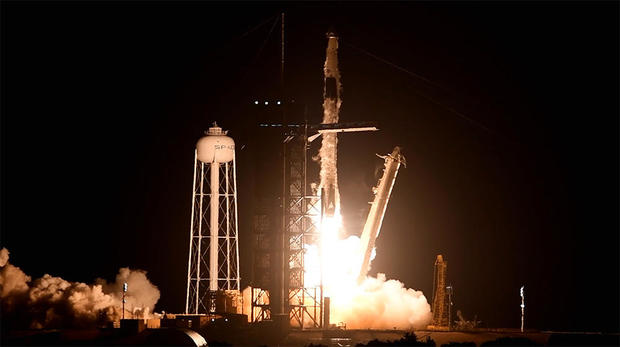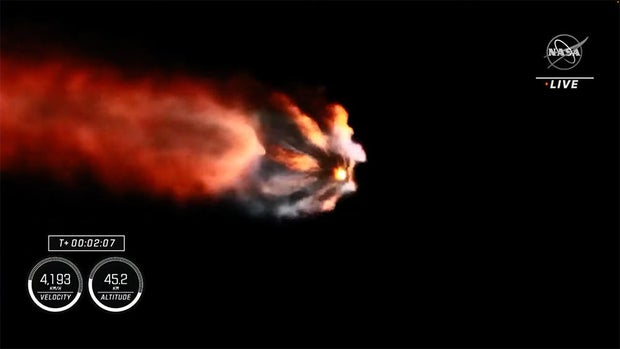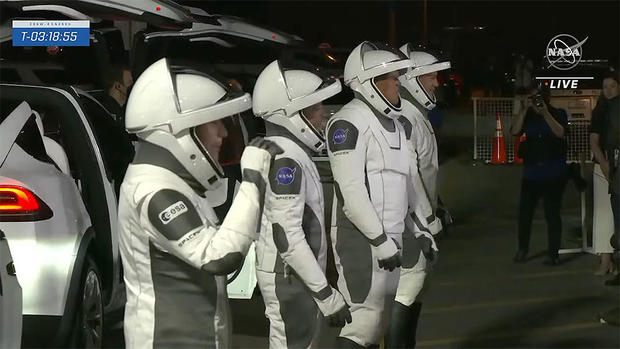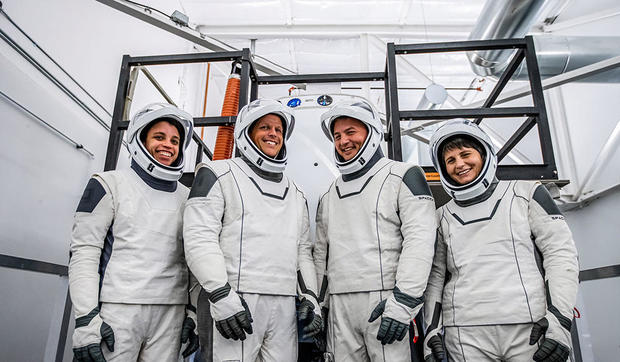On the heels of the first all-private commercial flight to the International Space Station, four professional astronauts rocketed away early Wednesday and set off to the lab complex to replace four long-duration station fliers who plan to return to Earth next week.
Strapped into a brand new SpaceX Crew Dragon capsule atop a Falcon 9 rocket, Crew-4 commander Kjell Lindgren, pilot Robert Hines, geologist-astronaut Jessica Watkins and European Space Agency astronaut Samantha Cristoforetti blasted off from historic pad 39A at the Kennedy Space Center at 3:52 a.m. EDT Wednesday.
Lighting up the deep overnight night sky for miles around, the slender rocket’s nine first stage engines, generating 1.7 million pounds of thrust, rapidly boosted the Crew Dragon away on a northeasterly trajectory directly into the plane of the space station’s orbit — a requirement for rendezvous missions.
Two-and-a-half minutes after liftoff, well out of the dense lower atmosphere, the first stage fell away, flipped around and headed for touchdown on an off-shore landing barge while the Falcon 9’s second stage continued the climb to orbit.
Then, in quick succession, the second stage engine shut down, the first stage successfully landed and the Crew Dragon was released to fly on its own. If all goes well, Lindgren and Hines will monitor an automated 16-hour 22-minute rendezvous with the space station, gliding in for docking at the Harmony module’s upper port at 8:15 p.m.
It is the second space flight for Cristoforetti and Lindgren, who flew to the station aboard Russian Soyuz spacecraft in 2014 and 2015 respectively, and the first flight for Watkins and Hines.
“I know a little bit what to expect during launch,” Lindgren said before takeoff. “But for me, getting to launch from here, from the Kennedy Space Center, from a historic launch pad with an incredible legacy of exploration, is very, very meaningful.”
The launching marked SpaceX’s 150th Falcon 9 flight, it’s 16th this year and its fifth this month.
It is the first flight for the Crew Dragon “Freedom,” the fourth and, for now, final Crew Dragon capsule to roll off the SpaceX assembly line in Hawthorne, California, and the fourth flight of the Falcon 9’s first stage, the most for any booster assigned to a NASA astronaut flight.
“This is (NASA’s) fourth crew rotation mission,” said Steve Stich, manager of NASA’s Commercial Crew Program. “It’s almost surreal that we’re here on this fourth mission, launching four crew (members) in the fourth month of the year on our fourth-flight booster. So it’s kind of a 4-4-4 mission for us. It’s a huge accomplishment for our team and the industry.”
The launch originally was planned for April 23, but the flight was delayed when high winds and rough seas postponed the return to Earth of four private citizens making the first fully-commercial visit to the space station. The Axiom 1 crew finally made it home Monday, splashing down in the Atlantic Ocean near Jacksonville, Florida, to clear the way for Crew-4’s takeoff.
The launch and rendezvous were timed to get the Crew-4 Dragon to the station well ahead of a spacewalk Thursday by cosmonauts Oleg Artemyev and Denis Metveev. As it is, the SpaceX capsule will dock while the station’s three cosmonauts are asleep.
Rather than waking them up early on the eve of a complex spacewalk, a traditional welcome-aboard ceremony for the Crew-4 astronauts will be delayed several hours until the cosmonauts, along with crewmate Sergey Korsakov, wake up to begin their busy day.
Lindgren’s crew is replacing Crew-3 commander Raja Chari, pilot Thomas Marshburn, submariner-turned-astronaut Kayla Barron and European Space Agency astronaut Matthias Maurer, launched to the space station last November.
Before heading home, the Crew-3 astronauts will familiarize their replacements with the ins and outs of station operations, reviewing safety procedures and ongoing research. If all goes well, Chari and his crewmates will undock next Wednesday and return to Earth to close out a 174-day mission.
“Once we get onto space station, we’ll have a little bit of adaptation time, still getting used to zero G (gravity), moving around, and just letting our bodies adapt to it,” Hines said.
“And while we’re doing that, we’ll also be talking with our crewmates up there. They’ll be handing off a lot of the things that they’ve been working on, teaching us some tricks of the trade and just some currency, really, of how things have been operating up there so that we can pick up and make a seamless transition.”
Watkins, who holds a doctorate in geology and helped plan the science carried out by NASA’s Curiosity Mars rover during a stint at the Jet Propulsion Laboratory, said the chance to study Earth from “from that vantage point, see all of the processes and features from that perspective, it’s just super exciting.”
And helpful to her crewmates.
“There are so many times where you’re looking at it … but you want to understand what it is that you’re looking at and there’s really no way to do that,” Lindgren said. “And now we have a way. So thank you ahead of time, Watty, for your service!”
Watkins will be the 17th African American to fly in space, the fifth woman of color and the first to make a long-duration stay aboard the space station. In a pre-launch interview with CBS News, she called that “an important milestone for the agency and for the country.”
“I certainly kind of stand on the shoulders of giants,” she said. “I am honored to be a small part of a legacy of black women astronauts that came before me and kind of laid the foundation and enabled me to be here today.
“It certainly has been important to me in my life to have role models that looked like me coming from backgrounds similar to mine that are contributing in ways that I aspire to contribute. And so to the extent that I’m able to do that, I’m definitely grateful for the opportunity.”
Lindgren and company plan to remain aboard the station until mid September, when another Crew Dragon will bring up their replacements.
The carefully choreographed crew rotation sequence comes amid heightened international tension as Russia’s invasion of Ukraine drags on, raising questions about the on-going cooperation required to operate the International Space Station.
Lindgren said NASA and his crew “are certainly not immune to the the geopolitical situation right now. These are very challenging times.”
“But this is our job,” he said. “We’ve been given the privilege of this mission, going to the space station, maintaining its operation, and conducting the science and research that so many from around the world have invested in, and in creating that operational bridge for the programs in front of us, moon and Mars. So we take that very seriously.”
And that includes working closely with Artemyev, Matveev and Korsakov, who arrived at the outpost March 18 aboard a Soyuz spacecraft.
“We very much look forward to getting on orbit and working with our Russian colleagues,” Lindgren said. “Oleg, Sergey and Denis are amazing space fliers. We’ve had the opportunity to train with them, to have meals with them and we very much look forward to working with them in orbit.”
NASA Administrator Bill Nelson said Tuesday he remains confident Russia will continue its participation in the International Space Station project through 2030.
“Despite the horrors that we are seeing with our eyes daily on television of what’s happening in Ukraine as a result of political decisions that are being made by the president of Russia, despite all of that … I see that professional relationship with astronauts and cosmonauts and the ground teams in the two respective mission controls, I see that continuing.”






